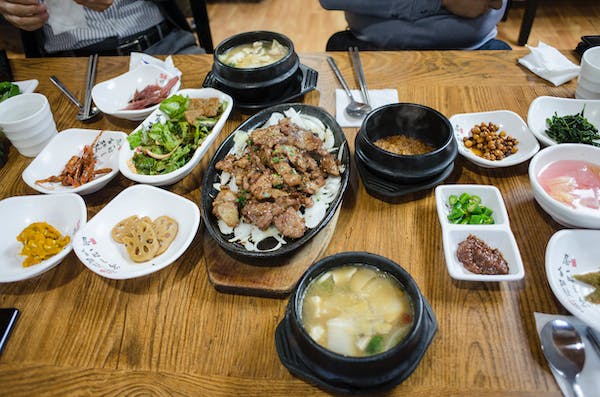Apart from K-Pop, K-Dramas, cosmetic products, tech giants, and its stunning country itself, another fascinating aspect of South Korea is its food culture! The nation has a unique and rich taste in terms of food, bringing many popular dishes, such as kimchi, bibimbap, kimbap, Korean barbecue, and delicious hot pots and soups to the world.
Truth to be told, food is everywhere in the country, available anytime in the day. You can find them in street food stalls, food joints, and restaurants even in the woo hours, proving how Koreans love their food. What’s more remarkable is that the Koreans have their own sets of eating customs that make their food culture even more astounding.
If you’re planning to travel to Korea, don’t simply study about the best Korean dishes to try. Here, we’ll delve deeper into the country’s food culture, allowing you to enjoy Korean cuisine better and have a more memorable, palatable experience.
Daily Food Culture
Rice is an essential part of daily Korean meals. Like in most other Asian countries, rice is a staple food in Korea. Their choice of rice is mepssal or more commonly known as short-grain rice, which is shorter and rounder and produces more starch compared to jasmine rice or basmati rice. Rice is a perfect match to Korean cuisine, which dishes are usually strong and assertive, usually with a distinct blend of spiciness, saltiness, and savoriness.
Moreover, Korean food requires various essential ingredients like gochujang (signature Korean sweet and spicy paste), red pepper flakes, garlic, black pepper, fermented soybean paste, rice vinegar, spring onion, and roasted sesame seeds, to name a few.
Typical main dishes include soups, pot-stews, pork, beef, dried fish, and steamed dishes. A wide array of side dishes are also prepared salads, pancakes, and fried or braised fruits and vegetables. Called Hanjeongsik, a full-Korean course meal consists of 10-20 dishes in small banchan plates, which all in all is extraordinarily delicious and colorful.
Street Food Culture
Another vital part of Korean food culture is its vibrant street food cuisine. After the Korean War, street food vendors have become abundant to offer cheaper options to Koreans with a lower standard of living. Today, street food has become popular and expanded to Cheonggyecheon Stream, Jongno, and Itaewon district, where street food alleys abound for locals and tourists.
From sweet, spicy, to savory, there are many mouthwatering street food and snacks to delight any food lover. Some famous options include tteokbokki, Korean corn dog, fish cake, pastries, pancakes, fried chicken, gimbap, dumplings, and other fried delicacies that are all a sight to behold. Korean street food serves as a sneak peek at the rich Korean cuisine.
Seasonal Food Culture
While there are staples, Koreans also enjoy certain foods per season. Korea has four seasons, causing seasonal vegetables and fruits to be available. Koreans consume them but have turned them into unique dishes, providing even more variety of eats every season.
For instance, fruits like cherries, kiwis, watermelon, peaches, grapes, and clementines are popular during the summer. Koreans eat them before or after meals and even during meals to fight the scorching heat. People also enjoy cold noodles like bibim-naengmyeon, mul-naengmyeon, memil-guksu, and the cold soup oi-naengguk. Meanwhile, patbingsu, Korea’s favorite dessert, made of shaved ice topped with red beans and ice cream, is also a surefire hit.
source:tookapic, CC0, via Wikimedia Commons
During fall, fruits like apples, pears, and persimmon become widely available in markets. Blue crab, prawns, and gizzard shads take the limelight in Korea’s culinary scene before the arrival of the long, cold winter. As the chilly weather arrives, locals eat cozy Korean foods like stews, noodle soup, and porridge. On the streets, hot snacks like hotteok (Korean sweet pancakes), gun bam (roasted chestnuts), and bungeo-ppang (fish-shaped pastry with red bean paste filling) are plentiful and can be found nearly on every street corner.
source:jyleen21, CC0, via Wikimedia Commons
Beverage Culture
Together with their meals, Koreans drink lots of different refreshments. It’s little wonder that numerous tea shops and cafés sprouted in the country. Other drinks come in various styles; some are alcoholic, others are not. There are ones intended for adults and for kids to enjoy.
One of their most popular drinks is soju. You can find it and its green bottle nearly in every store or place in Korea where they sell alcohol. Often called the “Korean vodka,” soju is traditionally derived from rice, barley, or wheat grains. The clear, colorless beverage contains 16.8% to 53% alcohol, depending on the brand. It’s best paired with Korean barbecue, fried trotter, ramyeon noodles, and grilled pork belly.
Other traditional drinks in Korea include sujeonggwa (Korean cinnamon punch), sikhye (sweet rice beverage), and makgeolli, with each of which having its own significance to Korea’s food culture.
Eating Customs
Koreans also have certain eating customs ingrained in Korean culture. Unlike in the West, Koreans enjoy communal dining, which means they have one main dish and are surrounded by many banchan dishes, which everyone shares on the table. Whether it’s grilled pork or stew, they love to share the same food as they eat together.
For utensils, Koreans use both chopsticks and spoons for eating. Spoon is primarily intended for scooping rice and drinking soup, while chopsticks are used for side dishes. Yet, it’s uncouth to use both simultaneously. Another customer is that seniors and elders must start eating first before the younger members pick their spoons and chopsticks.
Sharing is caring during Korean meals, but both hands are used to pass dishes, bowls, or glasses to show respect. It’s also deemed impolite to refill your own drinking glass, as the practice is to refill others’ while others refill yours.
Final Words
Korean food culture is undoubtedly rich and unique. By shedding light on their practices and attitudes towards food, you get to appreciate Korean cuisine more, show respect, and understand Korean identity beyond their fantastic food.
